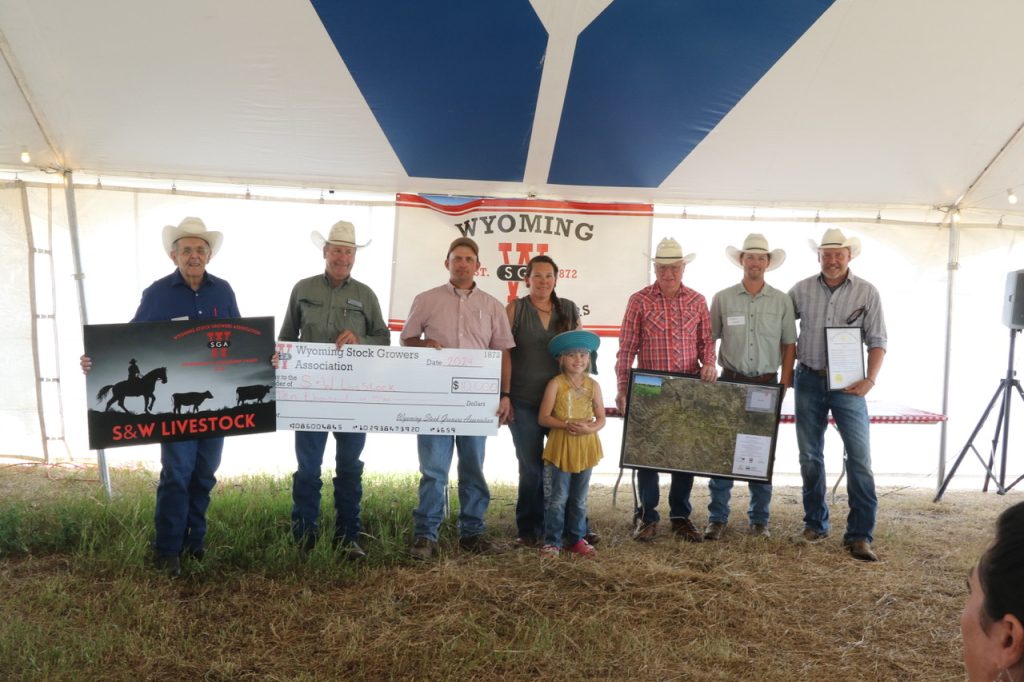Outstanding Stewardship: S&W Livestock earns the 2024 Environmental Stewardship Award

Each year, the National Cattlemen’s Beef Association (NCBA) presents the Environmental Stewardship Award which recognizes outstanding stewardship practices and conservation achievements of U.S. cattle producers across the nation.
State, regional and national award winners are selected for their commitment to protecting the environment and improving fish and wildlife habitats while operating profitable cattle operations.
A common trait among all award winners is the desire to leave the land in better shape for future generations while also inspiring the next generation of land stewards.
Here in the Cowboy State, the Wyoming Stock Growers Association (WSGA), Wyoming Department of Agriculture, Wyoming Game and Fish Department and Audubon Rockies are proud sponsors of this prestigious award and presented the honorable award to S&W Livestock, LLC on July 17 in Arvada.
“As the state award winner, S&W Livestock has the opportunity to move on to the regional-level selection process and hopefully onto the national selection process,” WSGA Executive Vice President Jim Magagna stated. “We wish them the best of luck. S&W Livestock’s history depicts their dedication and hard work conserving the land for the future.”
While the program highlights stewardship, it also provides fellow cattle producers with examples and ideas which may be useful on their own farm and ranching operations.
S&W Livestock
In 2013, the Spellman and Wood families joined forces to establish S&W Livestock developing a strong partnership based on trust.
The operation is an example of their dedication to the land they steward for themselves, their families and the greater good of the community for years to come.
Dusty Downey, event emcee, Audubon Rockies conservation ranching director and longtime friend of Don and Kathy Spellman and Lindsay and Dan Wood, described the S&W Livestock story as one of innovation, leading the next generation of ranchers.
Implementing electric fencing for rotational grazing while changing calving dates has helped the organization develop an intensive grazing system.
U.S. Department of Agriculture’s Natural Resources Conservation Service (NRCS) Wyoming State Conservationist Jackie Byam described S&W Livestock as a forward-thinking cattle operation.
“They continue to improve their land through water development projects, work with the NRCS on invasive grass control and invite resource professionals out to the ranch to visit so they can continue to improve their ranch management style and land stewardship,” Byam continued.
S&W Livestock collectively has taken responsibility for caring and managing their land by understanding what the land needs to maintain its long-term health.
The tour
After the award presentations, attendees gathered to share a meal before heading out to tour the ranch.
During the first stop on the tour, S&W Livestock Co-Owner Lindsay Wood explained the past and future grazing system of the ranch through water mitigation.
“We have been able to create improvements in our cattle while capturing water to maintain drought resistant plants,” she explained.
“Slowing down the water has helped us keep our pastures grazable, but the electric fencing has increased our ability to rotate the herd in and out of the pasture,” she added. “Plus, putting in electric fence is much easier than standard fencing, as one person can move the fence by themselves.”
Through research and experimentation, S&W Livestock learned frequent moves were more advantageous for forage production and animal performance.
“We have trained our livestock to respect electric fences. Keeping the training area small has helped reduce the time it takes cattle to discover the fence on their own,” she mentioned. “Most livestock, if sufficiently shocked, will not challenge an electric fence.”
“We have over 52 permanent pastures we can further divide with temporary electric fencing,” Don Spellman added.
During the tour, Lindsay explained their process in removing invasive grasses from their meadows and working with Wyoming Weed and Pest on the eradication project.
Dan Wood described how he has maintained pastures through various crop planting rotations.
Planting cover crops has multiple benefits such as controlling erosion, suppressing weeds, reducing soil compaction, increasing moisture and nutrient content of soil and improving yield potential.
“Getting back to a grass-alfalfa base is our end goal, but our long-term goal was to build up the soil base in these specific fields,” he explained.
Along with soil developments, S&W Livestock has made multiple improvements in their water distribution, improving livestock management which has allowed them to utilize miles of wildlife-friendly electric fencing, dividing their grazing lands into several pastures.
S&W Livestock has gone above and beyond standard industry conservation practices, and this dynamic operation is a positive example for others to learn from.
Melissa Anderson is the editor of the Wyoming Livestock Roundup. Send comments on this article to roundup@wylr.net.





